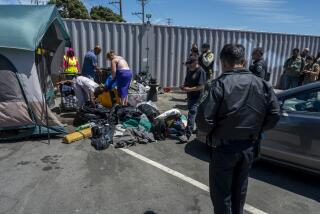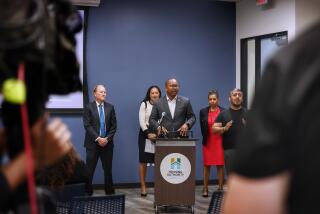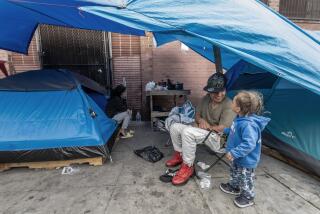Oceanside’s Fledgling Task Force Has Proved a Catalyst in Getting Help to Homeless
- Share via
Last winter was bitterly cold, unusually so for San Diego County. And Lucy Chavez, warm and cozy in her Oceanside home, couldn’t sleep.
She kept thinking about the people she had seen lining the streets of Oceanside, more and more in recent years, sleeping outside in the freezing night.
The City Council member visited the camps of migrant workers to see their living conditions firsthand. “I saw abject poverty,” she said. “I saw women and children in totally unpleasant, unlivable conditions.” It cost her a few more nights’ sleep.
On Thanksgiving, she volunteered her services at the Salvation Army, dishing up holiday meals. The people she met there were worried about where they would find shelter for the icy night ahead. For Chavez, that was the last straw.
“It always bothered me knowing there were people out there with nothing,” she said. “But seeing all these things together indicated to me that something needed to be done.”
Task Force Has Moved at Breakneck Speed
At the next council meeting in December, Chavez suggested to her fellow members that they do something. At her urging, the city established a task force for the homeless, whose 15 members range from lawyers to housewives to professional social workers.
In the seven months since its creation, the group has moved at breakneck speed in an attempt to provide help to the estimated 500 to 1,000 homeless people in the city.
Its first project, an innovative plan for a small trailer park to house homeless families on a short-term basis, will open late this year. A “homeless prevention” program, which will give money to people on the brink of eviction because of sudden financial crisis, is scheduled to begin Aug. 15.
Last month, the task force unveiled a plan to turn a crumbling building at Division Street and Center Avenue into a day center where the homeless can shower, shave, receive mail and make phone calls in preparation for job hunting. The structure, a former Americanization school for immigrants, was built in the early 1930s by noted architect Irving Gill and is recognized by the city as a historical site. But the domed building, now sagging and covered with graffiti, has stood unused for more than 20 years, according to architect Rob Royce, who hopes to participate in the building’s renovation if the plan is approved by the City Council.
Hopes for Habitat Project in Oceanside
The task force has also heard a presentation on Habitat for Humanity, an international project that provides housing built entirely by volunteers. The members expressed hope that a Habitat project can be built in Oceanside, if an appropriate site is found.
In addition, a task force subcommittee is working to obtain federal money to provide housing for migrant farm workers.
Frank Landerville, a spokesman for San Diego County’s Regional Task Force on the Homeless, said that Oceanside’s efforts are “paving the way” for the rest of the county.
“I think that the city of Oceanside is a fine example for other cities to follow,” he said. “They’re not trying to get rid of the homeless, they’re trying to get rid of homelessness.”
The group hasn’t done everything itself. The money for the prevention program will be distributed by the Ecumenical Service Center of North County, and two social service agencies are vying for the management of the trailer program. The day center, the brainchild of volunteers at Brother Benno’s soup kitchen in Oceanside, was in the works long before the task force was formed.
Acted as a Catalyst
But, in each case, the task force has acted as the catalyst to obtain the necessary funding, drum up community support and enlist the cooperation of City Hall.
“I think we’ve done wonders in a short amount of time,” said Councilwoman Melba Bishop, an alternate member of the group. “What I like is that we’re doing something and not just talking about it.”
Landerville estimates that 5,000 homeless people live in San Diego County, a figure that doesn’t include 8,000 to 10,000 migrant workers, many of whom live in abject conditions in rural camps.
Oceanside, Escondido and El Cajon are among the areas experiencing the most rapid increase of homelessness, as they become increasingly urban, he said.
Oceanside Housing Director Richard Goodman said the percentage of homeless people in Oceanside is probably no greater than in other North County cities. “But, at 117,000, we’re the biggest city in North County, so we definitely have more homeless because of our size,” he said. Goodman estimated that downtown Oceanside is host to 500 to 1,000 homeless.
The transient population of the city swells an additional 5,000 to 7,000 during the peak strawberry-picking season, from March to August, with the arrival of documented and undocumented farm workers, few of whom have housing other than tin and cardboard shacks in the fields, he said.
Timing Was Right
Goodman, who accompanied Chavez on her trips to the agriculture fields, recalled that, at the time of their visits, the county health department was moving to close some of the camps. “Because of the timing, people were sensitized to the issue.”
Goodman believes that the newly heightened public awareness of the plight of migrant workers contributed to the immediate success of the task force.
Its members agree that the group’s accomplishments are due in part to its dedication.
“There are many, many folks on the task force who give countless hours toward the poor,” said Chairman Nick Sauer. “I’ve just been very impressed with their efforts. I hope we can continue our momentum.”
Sauer, an attorney, said he believes that the unifying force on the task force is a shared and genuine concern for the poor.
“There is a homeless problem here, and we can’t hide it or give it a bus ticket out of town,” he said. “We have to deal with it in a caring and considerate way.”
Several Factors at Work
As the city’s liaison with the task force, Goodman sees several reasons for the recent flood of homeless in Oceanside. “The rents have gone up to where a lot of families can’t afford to pay it, period. Even substandard units in bad neighborhoods are more than they can afford.”
According to San Diego Municipal Judge Robert Coates, author of a book on homelessness, half a million low-income housing units are being destroyed and not replaced each year in America. In San Diego County, at least 50,000 families are spending more than half their income on rent. “Those families are precariously hanging on by their nails,” Coates said.
Both he and Goodman said a major factor in homelessness is the deinstitutionalization movement of the past decade.
“Over 75% of the mentally ill were released from the state hospitals,” Goodman said. “Many of them are now on the streets.”
Drugs, alcohol and the breakdown of the traditional family unit have also been mentioned by experts as factors.
“For our purposes, we’ve broken the homeless into three categories: the have-nots, the cannots and the will-nots,” Goodman said. “We don’t have a lot of desire to try to house the third group. We’re out to help those who want to help themselves.”
More Success Than Expected
“There are other schools of thought on that--some churches are out to help everyone, whether they want help or not,” he said. “That’s beyond the scope of what we feel we can do.”
Councilwoman Chavez said the group has met with more success than expected.
“We’ve done well, especially in comparison to some other cities,” she said. “Of course, we could do better. But I think that we’ve taken the lead, and we’d like other cities to do the same.”
Chavez believes that public officials should bear the brunt of responsibility for coming up with answers to homelessness.
“The solution is to make more affordable housing for more citizens,” she said. “Each state and each locality is going to have to solve that problem on its own, and work on a higher level with the county and the state.”
More to Read
Sign up for Essential California
The most important California stories and recommendations in your inbox every morning.
You may occasionally receive promotional content from the Los Angeles Times.










